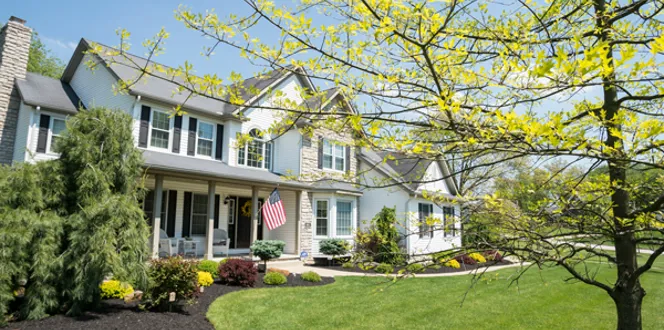Sycamores are grand, stately, shade trees known for their camouflage bark.
This massive tree has large attractive leaves and interesting fruit clusters that remain on the tree into winter, attracting birds. The long, stout trunk has beautiful exfoliating bark. The remarkable white, and brownish green bark flakes off in patches and exposes the inner bark, making this a beautiful tree throughout the year.
Think you have a sycamore tree in your yard or maybe you’d like to plant one? Let’s explore some sycamore tree identification tips.
Sycamore Tree Identification
The first thing you must ask yourself when looking for a tree like this for your yard is, “What does a sycamore tree look like?”
Let’s look at some of this tree’s distinguishing features.
Leaf Of A Sycamore Tree
Sycamore leaves are fairly large with three to five lobes. Their edges are like saw teeth and their undersides are fuzzy.
The veins of sycamore leaves radiate out from a single point as well.
Sycamore Tree Bark
The eye-catching bark of a sycamore tree is patterned and multi-colored, making it extremely interesting and alluring for home landscapes.
The bark is mottled that flakes off in large portions, giving the trunk surface a greenish-white and brown appearance.
As the tree ages, this intensifies with the addition of white patches.
Types Of Sycamore Trees
Sycamore trees belong to the genus Platanus.
There are 10 species of sycamore – seven of them grow in North America. Here are four you might commonly see in your landscape.
American Sycamore Tree – Also called the American plane tree, this tree generally grows to 100 feet tall, but can reach 150 feet. It grows in USDA hardiness zones 4 to 9.
California Sycamore Tree – This variety is a widely planted street and landscape tree in California. It’s a great tree for wildlife nesting. It grows in USDA Hardiness Zone 7 to 10, and in full to partial sun can reach a height of 40 to 100 feet with a 40- to 70-foot spread at maturity.
Arizona Sycamore Tree – Similar to the California sycamore, this tree is native to canyons, streams and rivers in south and central Arizona. Prized for its sculptural branches and trunk, this tree grows in USDA Hardiness Zones 7 through 11, and can grow up to 80 feet tall.
Old World Sycamore Tree – This tree, also known as the Oriental plane, has large maple-like leaves and distinctive, flaking brownish-gray and cream bark. It can grow to more than 60 to 80 feet in height with a rounded growth habit and horizontal branching. It grows best in USDA Hardiness Zones 7 to 9.
Sycamore Tree General Characteristics
Check out these sycamore tree characteristics to learn about the sycamore tree’s growth rate and to answer the question, “How fast do sycamore trees grow?”
- Grow zones: Sycamore trees grow best in USDA Hardiness Zones 4 to 9.
- Height/spread: Sycamore trees can grow to 75 to 100 feet in height with a 50- to 70-foot spread.
- Growth rate: The sycamore tree’s growth rate is defined as moderate to rapid, which is approximately 2 feet per year.
- Sunlight: Sycamore trees prefer full to partial sun, which equates to roughly four to six hours of sunlight daily.
- Best time to prune: Winter – outside of a sycamore tree’s active growth cycle – is the best time for pruning. This is after the leaves have dropped in late fall or before sap starts to flow in early spring – usually March.
Potential Threats
Anthracnose can be a challenge for some types of sycamore, grown in the eastern United States. This disease can lead to browning on all or portions of the leaves, usually beginning along leaf veins, but is more important as a canker disease on twigs and stems. Pruning out infected branches is the most effective control method for managing this disease.
The lace bug is a common pest of sycamore trees in the eastern United States. These pests feed on the undersides of leaves. They cause a stippled effect that can lead to browning leaves and then defoliation by late summer. Heavy infestations tend to be more common in urban areas. A certified arborist can help you properly identify and treat a lace bug problem.
When it comes to diseases, bacterial leaf scorch can be a problem for sycamore trees in the southern and eastern United States. It starts with an olive-green discoloration and then impacted leaves will turn brown and curl. To control this disease, it’s best to minimize stress from lack of water and avoid any unnecessary pruning, which could also overstress the tree. A certified arborist can give you other tips and help bring your tree back to good health.







